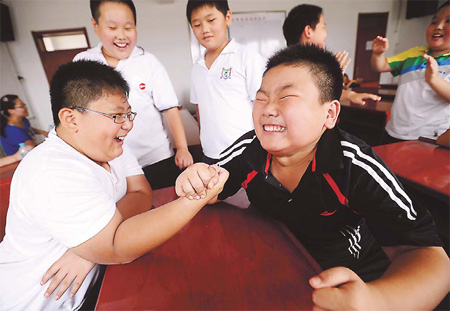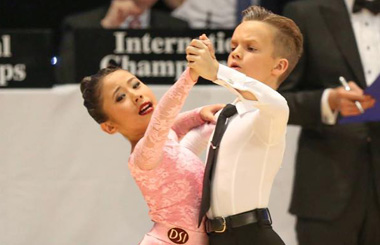Young students becoming fitter
 |
|
Two boys in a military training camp at an Armed Police base in Tianjin arm wrestle on Aug 13. More than 20 overweight children are attending the training course, which aims to help them lose weight. Provided to China Daily |
BEIJING - Although Chinese primary and middle school students are in better shape, the physical condition of college students continues to decline, said a senior official of the Ministry of Education.
"The 20-year continuous decline in our teenagers' health has slowed and we are happy to be seeing some improvements," said Yang Guiren, director of the Ministry of Education's physical education and fitness department.
"But the sharp decline in college students' physical health has been unexpected and has drawn a lot of concerns."
A national fitness survey, which tested 348,495 students who are between the ages of 7 and 22 and hail from 995 schools throughout the country, showed some encouraging signs. Since 2005, students between the ages of 7 and 18 have improved their performances in standing long jumps, 50-meter sprints and long-distance runs, as well as in flexibility and endurance tests.
The report also showed that Chinese students have enjoyed better nutrition and greater lung capacity in recent years.
Since 2005, the average lung capacity of male students between the ages of 19 and 22 has increased by 137 milliliters. And that of females of the same age has increased by 102 milliliters.
At the same time, the number of malnutrition cases among students has dropped by 0.27 percent during the same period.
The health of college students, meanwhile, has declined significantly. And juvenile myopia, or nearsightedness, is becoming more common and appearing in younger and younger children.
Yang said there are several reasons for the disappointing results. Students are not getting enough exercise and there are not enough gymnasiums and similar places where they can go to keep themselves in shape. As for the increase in myopia cases, he pointed to China's education system, which imposes heavy burdens on the young to prepare them for examinations.
To make things better, Yang called on families and society to work closely with schools and local education departments.
"The central government has placed a great emphasis on ensuring students are in good shape, but the important thing is to make these intentions into realities," Yang said. "We need help from every part of society to get the intended results."
In 2007, the Communist Party of China Central Committee and the State Council jointly issued a notice on improving physical education in schools and the physical condition of students. The regulations require primary and middle schools to hold one-hour group exercise sessions on days when there are no physical education classes.


















